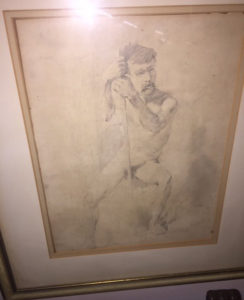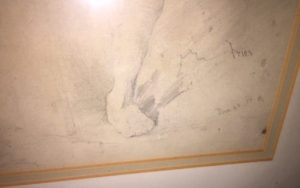 JE owns a “life study” figure by Charles Arthur Fries (1854-1940). Why did Fries, known in his later years for his Southern Californian landscape paintings, sketch a strange little nude man? We see the little figure looking at us, perhaps slightly embarrassed for hiding his ‘maleness’ behind a long pole, obviously in the nude, in front of a group of students. What is the tradition behind this little sad looking sketch?
JE owns a “life study” figure by Charles Arthur Fries (1854-1940). Why did Fries, known in his later years for his Southern Californian landscape paintings, sketch a strange little nude man? We see the little figure looking at us, perhaps slightly embarrassed for hiding his ‘maleness’ behind a long pole, obviously in the nude, in front of a group of students. What is the tradition behind this little sad looking sketch?
Fries, who signed the work, began his artistic life in Cincinnati 1874, where he attended art classes at the McMicken School of Design, later called the Art Academy of Cincinnati. The director of that institution at that time, the painter Thomas Satterwhite Noble (1835-1907), ran the life study classes. Noble known for his very moving paintings of slave life, painted with emotionally rendered figures in support of the Abolitionist cause. Noble studied ‘Academic’ painting in Paris with Thomas Couture (1815-79). Noble returned to the American South before the Civil War, and then served in the Confederate army from 1862-65. He attained the appointment in Cincinnati in 1869.
An Academic course of study necessarily included the drawing of figures ‘from life’, a class held with a live model, usually naked. This Academy figure study class became the cornerstone of art education.
Male students sketched from “life” from both male and female nude models. Women were barred from this practice, until a groundbreaking class in 1893 at The Royal Academy in London. Even then, the model remained partially draped.
Thus, JE owns an early work by CA Fries, a young artist’s academy figure sketch of a live nude male model, armed with a judiciously placed pole. The use of a prop indicates that this little model was ‘caught’ by the young Fries in a ‘gesture’ drawing. I can only imagine the classroom on that day.
A “gesture drawing” occurred at the beginning of a life class, when the instructor asked the model to perform a series of short live poses. The students warm up by capturing the essence of each pose. Anyone who has attended a life study class will know how easy it is to sketch ‘to the paper’ and not ‘to the model.’ These art student gesture drawings, when good, are fast, free, and use the whole arm. Thus, JE’s sketch captures the weight shift of the little male nude model upon his pole, directly on the paper. I have no idea why CA Fries saved this sketch, but I bet he felt amused by the little male model, peering out from behind the pole.
Why, asks JE, is this little model so ugly?
 Academy figures are drawn from less than ideally proportioned human models for two reasons.
Academy figures are drawn from less than ideally proportioned human models for two reasons.
- Not all human beings painted in an artist’s career will be perfect.
- If the model appears imperfect looking, sex might not enter the classroom (in theory at least).
So this man is such a non-sexualized model, an imperfect little man beckoned into the Art School from the streets of Cincinnati with the promise of a sitter’s fee.
A sketch from life is difficult. Above all things an artist renders, the human eye will recognize one’s failures to capture an authentic looking human. Academic Art Schools canonized a rule about human proportions. You and I, average proportioned humans, stand seven and a half heads tall, including our heads. A dancer, a great beauty, a person of great grace, will stand eight heads tall. A male hero, a warrior, a tall and virile screen heartthrob, rises to eight and a half heads tall. Face it, we consider males with broader longer chests and longer legs. your great modern athlete, more sublime.
Now to value.
Although a Fries oil of a beautiful San Diego mountain scene can sell for $10K, JE’s life study represents a young artist at school learning to draw a homely older model in 1874. Student works are not considered as valuable. The artist has not developed his own style. I estimate this sketch would sell for $300-400.